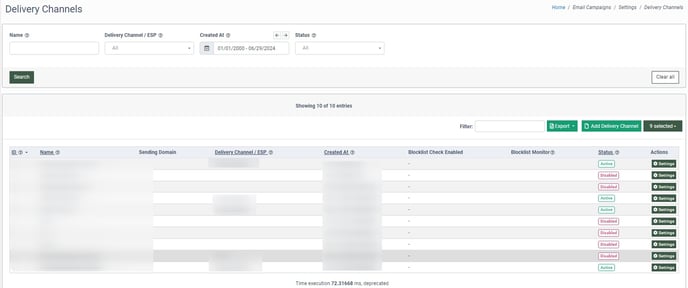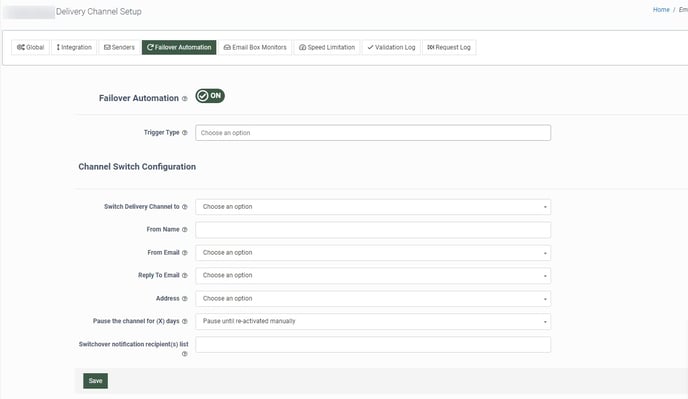The Delivery Channels section allows you to add and configure ESP Delivery Channels and Campaign integrations.
To view the Delivery Channels list, go to the Email Campaigns > Settings > Delivery Channels section.

The delivery channel list contains the following information:
- ID: The unique identification number of the Channel.
- Name: The name of the Channel.
- Delivery Channel / ESP: The type of the Channel.
- Created At: The date of Delivery Channel / ESP creation.
- Status: The status selected for the Channel (Active, Deleted, Disabled, Duplicating).
You can narrow down the search results by using the following filters:
- Channel name: Enter the name of the Channel.
- Delivery Channel / ESP: Select the Channel type.
- Created At: Select the date it was created.
- Status: Select the status of the Channel.
To create a new Channel, click the “Add Delivery Channel” button. Next, fill in the name of the Channel in the “Name” field and click the “Add” button to complete.

To configure the existing Channel, click the “Settings” button in the “Actions” column, and the system will redirect you to the setup page.
The “Delivery Channel Set Up” page contains seven tabs:
Global
The “Global” tab allows you to make general changes to the Channel, such as renaming, changing the status, or deleting a Channel.
The “Global” tab contains the following settings:
- Name: Enter a new name for the Channel.
- Status: Select a new status via the “Change Status” pop-up window and click the “Save” button.

To delete it, click the “Delete Channel” button. Check the Channel configuration process by clicking the “Validate Channel Settings” button. Click the “Save” button to complete.
Integration
The “Integration” tab allows you to select the required ESP (such as MailGun, MailJet, Postmark, AmazonSES, and others) in the “Select ESP” field. Fill in the required fields based on the selected ESP type. The set of fields depends on the ESP type.

Senders
The “Senders” tab allows you to configure sending or replying options. The “Senders” tab contains the following information:
- ID: The unique identification number of the sender.
- From Name: The name of the sender.
- From Email: The email of the sender.
- Sender Address: The sender's address (Address, City, State, ZIP / Postal).

To add a new sender email address to the list, click the “Add Sender” button. Fill in the following fields in the “Add New” pop-up window:
- From Name: Enter the name of the sender.
- From Email: Enter the email of the sender.
- Sender Company Name: Enter the company name of the sender.
- Sender Address: Enter the address of the sender.
- Sender City: Enter the city of the sender.
- Sender State / County: Enter the state or county of the sender.
- Sender ZIP / Postal: Enter the ZIP or Postal code of the sender.
 Click the “Add” button to add a sender.
Click the “Add” button to add a sender.
To complete the sender setup, verify the sender's email by inputting the verification code sent in the email. Click the “Confirm” button to send the verification email and enter the verification code in the pop-up window. Click the “Resend Code” button to resend the code.

To make any changes to the sender record, click the “Edit” button in the “Actions” column and enter new data in the “Edit” field in the pop-up window.
Click the “Set As Default” button in the “Actions” column to change the default sender.

Click the “Delete” button in the “Actions” column to delete the sender.

Failover Automation
The "Failover Automation" tab allows you to set up a calculation rate of failed Emails for the specified channel. This setting allows the system to automatically switch the delivery channel (and all associated campaigns) to a new one.
We consider the following event names to be failed messages: “Sent Failed”, “Delivery Failed”, “Soft Bounce”, and “Hard Bounce”.
The “Failover Automation” tab contains the following settings:
- Failover Automation: Switch the toggle to the “ON” position to enable the failover automation feature.
- Trigger Type: Select the trigger type for the Failover Automation.
Performance Based Failover
- Maximum % of failed messages: Enter the maximum percentage ratio of total Emails sent in the past (..) hours over the number of failed sent and failed delivery Emails.
- Minimum number of failed messages: Enter the minimum percentage ratio of the total number of failed Emails in the past (..) hours.
- Failed messages within the past: Select the number of past hours to accumulate for the Failed Rate (From 1 hour to 24 hours).
Channel Switch Configuration
- Switch Delivery Channel to: Select the active Email delivery channels to which the system will switch once the failover automation gets triggered.
- From Name: Select the name of the sender.
- From Email: Select the email of the sender.
- Reply To Email: Select the recipient’s email address.
- Address: Select the sender’s address.
- Pause the channel for x days: Select the number of days during which the Email channel will pause once the failover automation gets triggered. You may also choose the option to reactivate the channel manually.
Note: The paused channel will get the "Fail Over Paused" status. It could be switched to the "Active" status in two cases:
-
- Users can change the channel’s status manually in the “Global” tab.
- The number of selected days has passed.
- Switchover notification recipient(s) list: Enter the email address to send the failover notifications once triggered.

To complete the setup process, click the “Save” button.
Email Box Monitors
The “Emails box monitors” tab allows you to set the inbox monitoring for the selected email boxes and automatically add emails to the unsubscribe or global suppression lists based on the detected keywords.

The “Emails Box Monitors” tab contains the following information:
- ID: The unique identification number of the Email Box Monitor.
- Host Name: The host name of the Email Box Monitor.
- Email: The email address of the Email Box Monitor.
- User name: The user name of the Email Box Monitor.
- Status: Status of the Email Box Monitor.
Click the “Add Box” button to set up the email box monitors and fill in the following fields in the “Add New” pop-up window:
- Host name: Enter the SMTP connection type of your email address (imap.gmail.com, pop.mail.yahoo.com, etc.).
- Email: Enter the email address to receive the Unsubscribe and Global Suppression reply emails.
- Username: Enter the user name for the Email monitor (same as the email address).
- Password: Enter the password from your email address.
- Service: Select the email protocols (IMAP, POP3).
- Port: Enter the port number.
- Protocol: Select the protocol (NOTLS, TLS, SSL).
- Keyword(s) comma-separated (Unsubscribe): Enter the keyword (Stop, No, etc.).
Note: The system will check the emails for entered keywords and mark them as Unsubscribe if the keywords are found.
- Keyword(s) comma-separated (Global Suppression): Enter the keyword (Stop, No, etc.).
Note: The system will check the emails for entered keywords and mark them as Unsubscribe if the keywords are found.
Click the “Save” button to confirm.

Speed Limitation
The “Speed Limitation” tab allows you to set a monthly delivery cap and delivery speed limitation for sending out Email campaigns. The “Speed Limitation” tab contains the following settings:
- Monthly Cap Limitation: Switch the toggle to the “ON” position to enable the monthly cap limitation settings.
- Cap Per Month: Enter the required values.
- Speed Limitation: Switch the toggle to the “ON” position to enable the speed limitation settings.
- Speed: Enter the total number of emails to send during the selected interval.
- Interval: Select the time interval that specifies the maximum cap of emails sent during the chosen time frame.
Note: This option is enabled by default (The default speed is 100 per hour). The Speed Limitation option will set limitations for all campaigns on the selected channel. To configure the Speed Limitation on a campaign level, go to Email Campaigns > Campaigns, select the campaign, and click the “Configure” button in the Actions column. Select the Sending Option(s) tab, enable the Limiter, and set the limitations for the campaign.

To complete the setup process, click the “Save” button.
Validation Log
The “Validation Log” tab allows you to view the Email Monitor validation history. The “Validation Log” tab contains the following information:
- Time: The exact time of the event.
- Type: The type of the event.
- Message: The information about the event.

Request Log
The “Request Log” tab displays the Email Monitor log entries and their duration. The “Request Log” tab contains the following information:
- Time: The exact time of the event request.
- Uri: Uniform Resource Identifier of the event request.
- Duration: The duration of the event request.

Click the “View” button in the “Action” column to view the complete information about the log.

